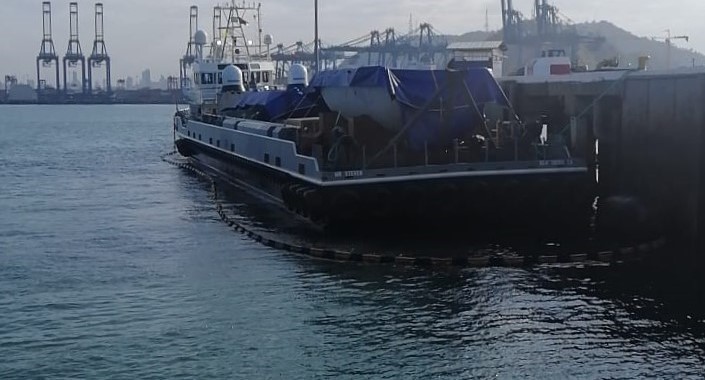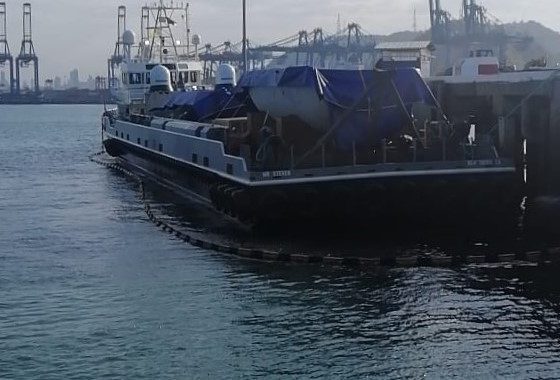

News
SpaceX’s Mr. Steven crosses Panama Canal on 5000 mile journey to Florida
Iconic SpaceX vessel Mr. Steven has completed a successful transit of the Panama Canal as of February 7th, leaving the fairing recovery ship approximately 3-4 days from arrival at its new home in Port Canaveral, Florida.
Mr. Steven’s move from the West Coast to the East Coast comes shortly after a series of controlled fairing recovery tests – dropped by helicopter before deploying a parafoil – brought the vessel closer than ever before to successfully snagging a Falcon fairing out of the air. Thanks to webcams at the landmark, Mr. Steven’s trip through the Panama Canal also revealed that his arms were uninstalled for the coast swap, while two fairing halves – covered in tarps – stood out on the ship’s large deck.
Aaaaand the grand finale, a gif of Mr. Steven’s transit through the Panama Canal’s first western lock (Miraflores). Probably the last we’ll see of him until Port Canaveral, with an ETA around ~4 days from now 🙂#SpaceX pic.twitter.com/DIus6K5hK5
— Eric Ralph (@13ericralph31) February 7, 2019
Although the presence of two fairing halves could be a sign of something else, it could indicate that SpaceX has plans to continue its controlled fairing drop/recovery tests, albeit this time in the Atlantic Ocean. Thanks to a sharp-eyed local observer, it can be observed that, while topped with tarps and safely secured, the fairing halves aboard Mr. Steven had no additional protection against sea spray and the elements over the course of a 5000+ mile (~8000 km) journey at a cruising speed of roughly 20 mph (~32 km/h). In other words, they are most certainly not going to be reused.
If not for reuse, then the only reason Mr. Steven would need to bring fairings to Florida is if there is some need for fairing recovery development hardware (halves that can be abused without opportunity cost), either for more basic mechanical and interface tests with fairings and nets or to continue SpaceX’s program of experimental drop testing.
Is your #MrSteven here in Panama @elonmusk and @SpaceX ? pic.twitter.com/GvTNGYQU9K
— Hugo Tello (@soyhugotello) February 6, 2019
Intriguingly, although SpaceX released a second video of “one” of Mr. Steven’s final West Coast catch tests, some basic sleuthing can easily determine that the test shown in the January 29th video probably occurred more than two weeks earlier, on January 10th. This means that one final helicopter drop test was performed (January 26th) before SpaceX departed Port of LA for Florida on the 29th. Some might conclude, then, that SpaceX’s latest drop tweet was more than a little coy, perhaps indicating that the results of the Jan 26 test may have been appreciably different than the extreme near-miss experienced on the 10th.
While the company’s history – combined with CEO Elon Musk’s welcome tendency of sharing good news almost as soon as he hears it – suggests that the Jan 26 test was probably not a success, SpaceX could be playing its development cards close to its chest when it comes to fairing recovery.
One of Mr. Steven’s final West Coast fairing recovery tests before shipping out for the East Coast. Wait for it… pic.twitter.com/A7q37Gpllu
— SpaceX (@SpaceX) January 30, 2019
Regardless, SpaceX clearly has no plans to end its experimental fairing recovery program with success so agonizingly within reach. Mr. Steven’s move to Florida sets the vessel up for a dramatic increase in available post-launch fairing recovery attempts at the same time as Falcon fairings likely still cost around $3 million apiece and continue to pose the same conundrum Musk raised in mid-2017.
“Imagine if we had a $6 million pallet of cash falling through the sky. Would we try to catch it? I think the answer is yes.” – Elon Musk, July 2017
Although the cost of SpaceX’s fairing recovery program is probably several tens of millions of dollars at this point, it seems probable that Musk would still stand behind his thought experiment. Assuming SpaceX can cost-effectively reuse fairings once recovery is assured, a development program costing upwards of $50-100M could be entirely recouped after just 10-20 dual fairing recoveries, compared to the 21 fairings SpaceX flew in 2018 alone. As long as Falcon 9 and Heavy are likely to continue operating for several more years (all but guaranteed), fairing recovery should still prove worthwhile if SpaceX can close the recovery gap within the next 6-12 months.
Check out Teslarati’s newsletters for prompt updates, on-the-ground perspectives, and unique glimpses of SpaceX’s rocket launch and recovery processes!

News
Elon Musk’s Grok AI to be used in U.S. War Department’s bespoke AI platform
The partnership aims to provide advanced capabilities to 3 million military and civilian personnel.

The U.S. Department of War announced Monday an agreement with Elon Musk’s xAI to embed the company’s frontier artificial intelligence systems, powered by the Grok family of models, into the department’s bespoke AI platform GenAI.mil.
The partnership aims to provide advanced capabilities to 3 million military and civilian personnel, with initial deployment targeted for early 2026 at Impact Level 5 (IL5) for secure handling of Controlled Unclassified Information.
xAI Integration
As noted by the War Department’s press release, GenAI.mil, its bespoke AI platform, will gain xAI for the Government’s suite of tools, which enable real-time global insights from the X platform for “decisive information advantage.” The rollout builds on xAI’s July launch of products for U.S. government customers, including federal, state, local, and national security use cases.
“Targeted for initial deployment in early 2026, this integration will allow all military and civilian personnel to use xAI’s capabilities at Impact Level 5 (IL5), enabling the secure handling of Controlled Unclassified Information (CUI) in daily workflows. Users will also gain access to real‑time global insights from the X platform, providing War Department personnel with a decisive information advantage,” the Department of War wrote in a press release.
Strategic advantages
The deal marks another step in the Department of War’s efforts to use cutting-edge AI in its operations. xAI, for its part, highlighted that its tools can support administrative tasks at the federal, state and local levels, as well as “critical mission use cases” at the front line of military operations.
“The War Department will continue scaling an AI ecosystem built for speed, security, and decision superiority. Newly IL5-certified capabilities will empower every aspect of the Department’s workforce, turning AI into a daily operational asset. This announcement marks another milestone in America’s AI revolution, and the War Department is driving that momentum forward,” the War Department noted.
News
Tesla FSD (Supervised) v14.2.2 starts rolling out
The update focuses on smoother real-world performance, better obstacle awareness, and precise end-of-trip routing, among other improvements.

Tesla has started rolling out Full Self-Driving (Supervised) v14.2.2, bringing further refinements to its most advanced driver-assist system. The new FSD update focuses on smoother real-world performance, better obstacle awareness, and precise end-of-trip routing, among other improvements.
Key FSD v14.2.2 improvements
As noted by Not a Tesla App, FSD v14.2.2 upgrades the vision encoder neural network with higher resolution features, enhancing detection of emergency vehicles, road obstacles, and human gestures. New Arrival Options let users select preferred drop-off styles, such as Parking Lot, Street, Driveway, Parking Garage, or Curbside, with the navigation pin automatically adjusting to the user’s ideal spot for precision.
Other additions include pulling over for emergency vehicles, real-time vision-based detours for blocked roads, improved gate and debris handling, and extreme Speed Profiles for customized driving styles. Reliability gains cover fault recovery, residue alerts on the windshield, and automatic narrow-field camera washing for new 2026 Model Y units.
FSD v14.2.2 also boosts unprotected turns, lane changes, cut-ins, and school bus scenarios, among other things. Tesla also noted that users’ FSD statistics will be saved under Controls > Autopilot, which should help drivers easily view how much they are using FSD in their daily drives.
Key FSD v14.2.2 release notes
Full Self-Driving (Supervised) v14.2.2 includes:
- Upgraded the neural network vision encoder, leveraging higher resolution features to further improve scenarios like handling emergency vehicles, obstacles on the road, and human gestures.
- Added Arrival Options for you to select where FSD should park: in a Parking Lot, on the Street, in a Driveway, in a Parking Garage, or at the Curbside.
- Added handling to pull over or yield for emergency vehicles (e.g. police cars, fire trucks, ambulances).
- Added navigation and routing into the vision-based neural network for real-time handling of blocked roads and detours.
- Added additional Speed Profile to further customize driving style preference.
- Improved handling for static and dynamic gates.
- Improved offsetting for road debris (e.g. tires, tree branches, boxes).
- Improve handling of several scenarios, including unprotected turns, lane changes, vehicle cut-ins, and school buses.
- Improved FSD’s ability to manage system faults and recover smoothly from degraded operation for enhanced reliability.
- Added alerting for residue build-up on interior windshield that may impact front camera visibility. If affected, visit Service for cleaning!
- Added automatic narrow field washing to provide rapid and efficient front camera self-cleaning, and optimize aerodynamics wash at higher vehicle speed.
- Camera visibility can lead to increased attention monitoring sensitivity.
Upcoming Improvements:
- Overall smoothness and sentience.
- Parking spot selection and parking quality.
News
Tesla is not sparing any expense in ensuring the Cybercab is safe
Images shared by the longtime watcher showed 16 Cybercab prototypes parked near Giga Texas’ dedicated crash test facility.

The Tesla Cybercab could very well be the safest taxi on the road when it is released and deployed for public use. This was, at least, hinted at by the intensive safety tests that Tesla seems to be putting the autonomous two-seater through at its Giga Texas crash test facility.
Intensive crash tests
As per recent images from longtime Giga Texas watcher and drone operator Joe Tegtmeyer, Tesla seems to be very busy crash testing Cybercab units. Images shared by the longtime watcher showed 16 Cybercab prototypes parked near Giga Texas’ dedicated crash test facility just before the holidays.
Tegtmeyer’s aerial photos showed the prototypes clustered outside the factory’s testing building. Some uncovered Cybercabs showed notable damage and one even had its airbags engaged. With Cybercab production expected to start in about 130 days, it appears that Tesla is very busy ensuring that its autonomous two-seater ends up becoming the safest taxi on public roads.
Prioritizing safety
With no human driver controls, the Cybercab demands exceptional active and passive safety systems to protect occupants in any scenario. Considering Tesla’s reputation, it is then understandable that the company seems to be sparing no expense in ensuring that the Cybercab is as safe as possible.
Tesla’s focus on safety was recently highlighted when the Cybertruck achieved a Top Safety Pick+ rating from the Insurance Institute for Highway Safety (IIHS). This was a notable victory for the Cybertruck as critics have long claimed that the vehicle will be one of, if not the, most unsafe truck on the road due to its appearance. The vehicle’s Top Safety Pick+ rating, if any, simply proved that Tesla never neglects to make its cars as safe as possible, and that definitely includes the Cybercab.








